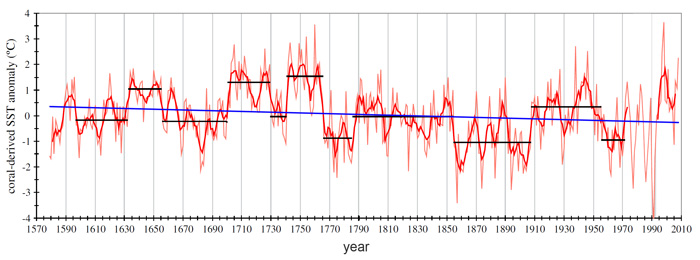| Tweet | Follow @co2science |
Paper Reviewed
Kawakubo, Y., Alibert, C. and Yokoyama, Y. 2017. A reconstruction of subtropical Western North Pacific SST variability back to 1578, based on a Porites coral Sr/Ca record from the Northern Ryukyus, Japan. Paleoceanography 32: 1352-1370.
While much remains to be learned about historic temperatures over land, even more remains to be discovered for historic temperatures over the ocean. A recent study helping to fill this knowledge-gap was conducted by Kawakubo et al. (2017).
For their work, the three scientists set out to create a long-term sea surface temperature reconstruction for the subtropical Western North Pacific. This was accomplished by analyzing coral Sr/Ca ratios from a Porites coral located off the south coast of Kikai, Japan (~28.3°N, 130°E). Calibrating the record with modern temperature measurements allowed the researchers to create the proxy sea surface temperature reconstruction below, covering the period 1578-2008.
As illustrated in the figure, Kawakubo et al. report that "the Kikai coral record shows some significant decadal to interdecadal variability, [including] colder than average temperature between 1665-1700 (coinciding with the Maunder Minimum), 1766-1788, 1855-1900, and during the 1960s and warmer than average temperature[s] between 1700-1730, 1740-1760, 1930-1950, and since 1990."
Perhaps the most striking feature of the reconstruction, however, is the fact that, in the words of the authors, it "does not show any significant long-term trend, only a slightly negative trend mainly driven by decreasing summer temperatures."
The slight decline in temperature, let alone the absence of warming in this 431-year record is really quite startling -- that is, of course, if you are a climate alarmist and believe that rising atmospheric CO2 concentrations are driving global temperatures to levels of warmth that are unprecedented in the past millennia or more. For the rest of us who recognize that the climate sensitivity of rising atmospheric carbon dioxide is much smaller than climate models project, the lack of an increasing temperature trend over this period is no surprise at all.

Figure 1. Time series of annual mean coral-derived SST anomalies (thin red line), with a 5 year running trend (bold red line) highlighting decadal to interdecadal variations. The trend line is shown in blue. Significant temperature regime periods are shown in black. The 5-year running trend was not computed for the period 1976-1992 due to what the authors describe as less reliable coral data during this period Source: Kawakubo et al. (2017).




